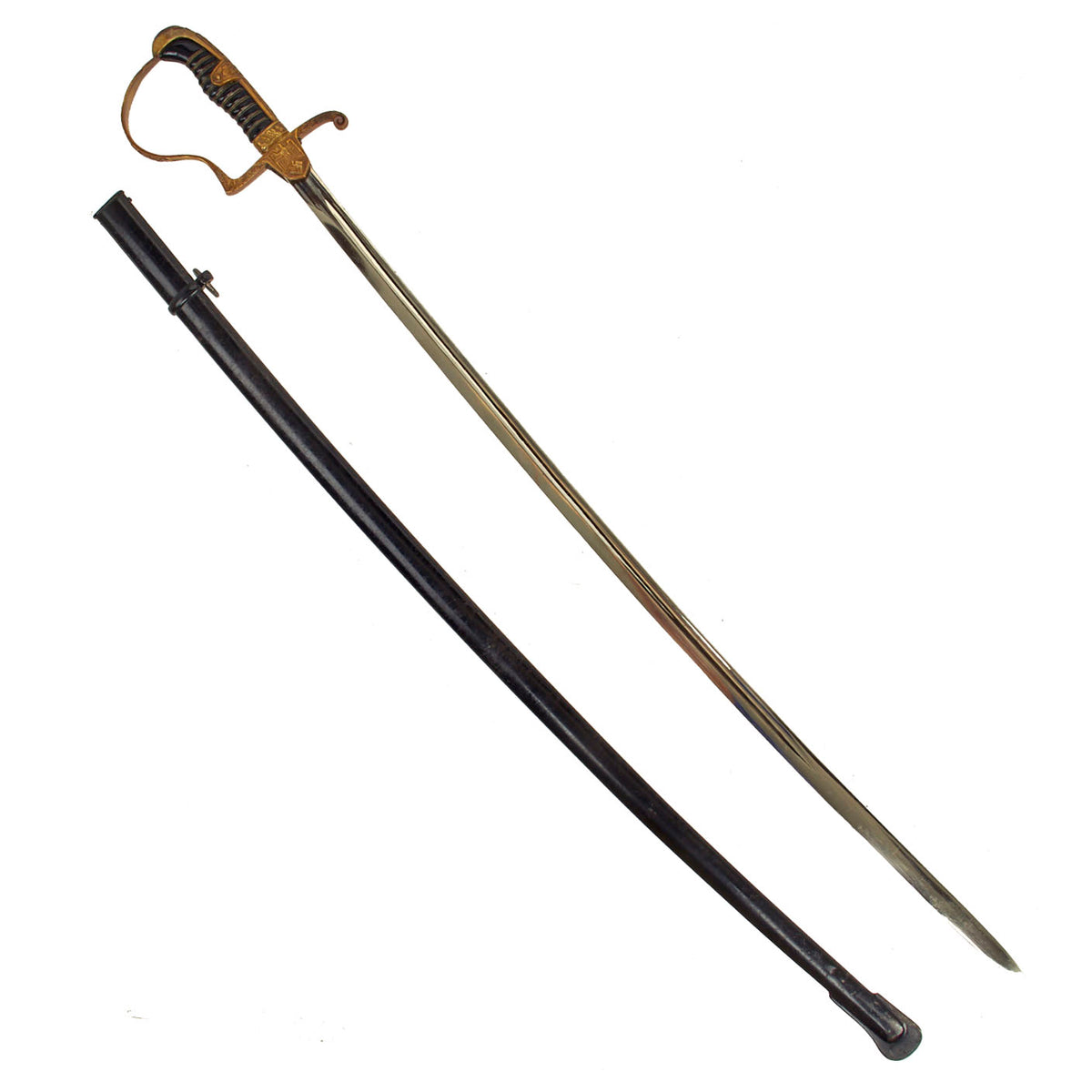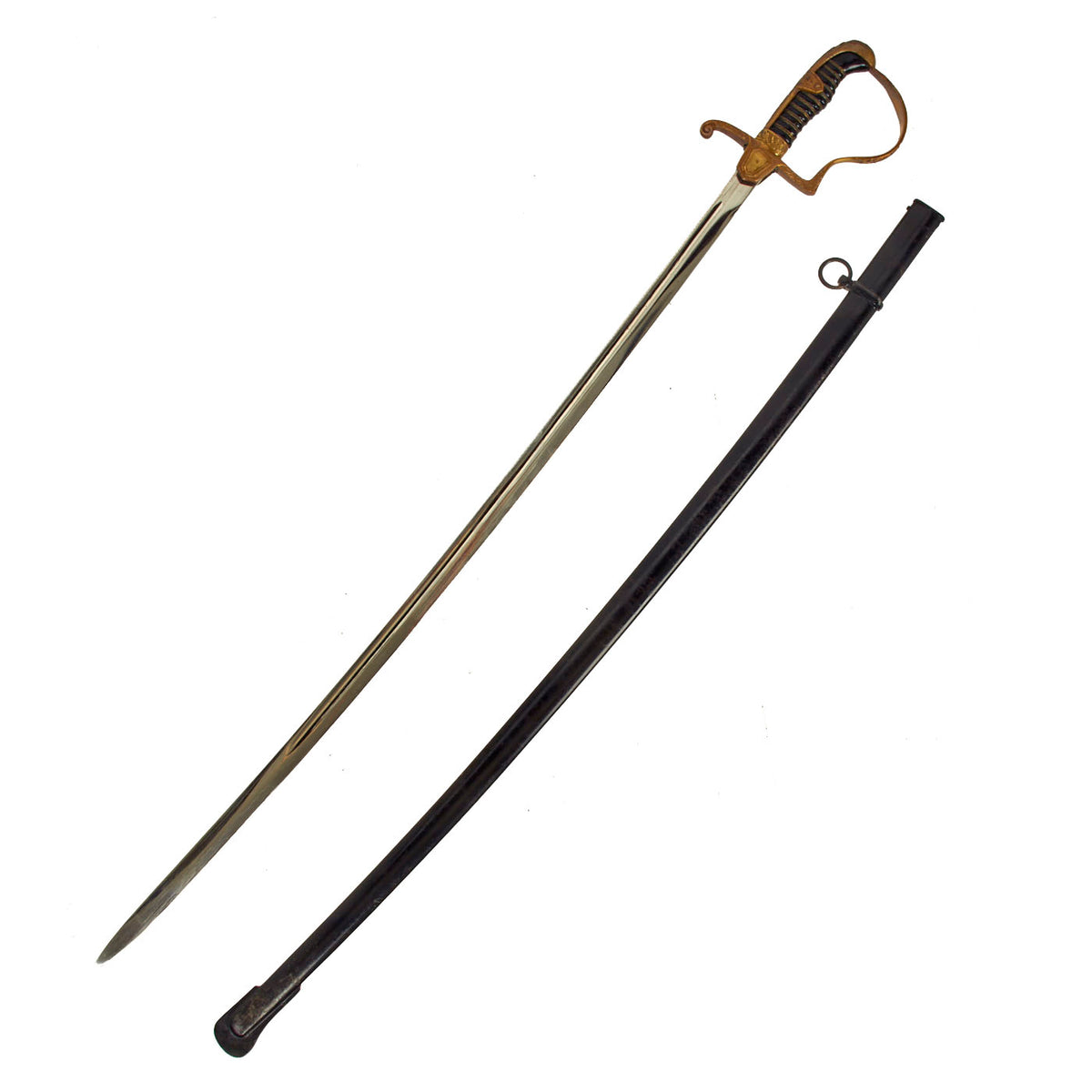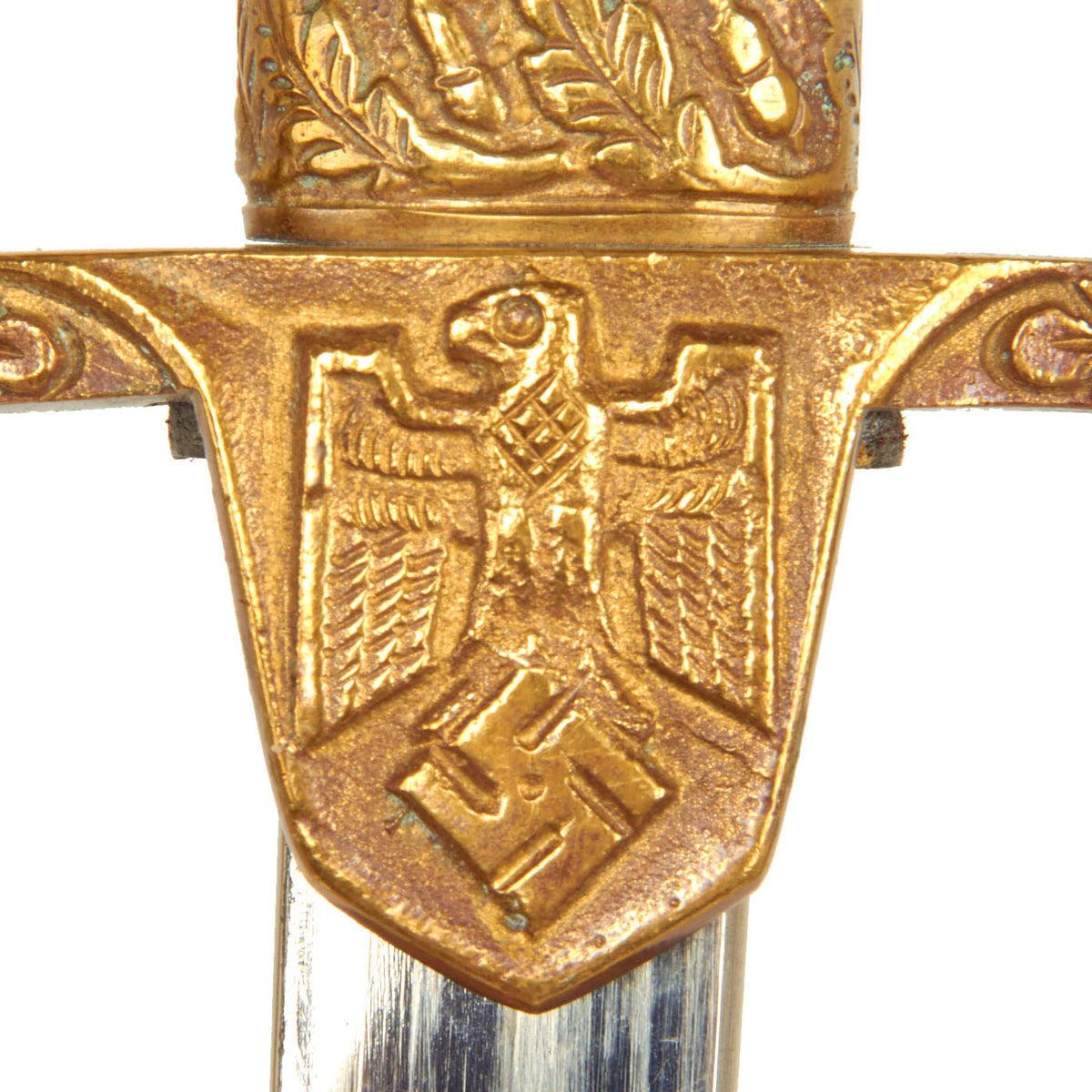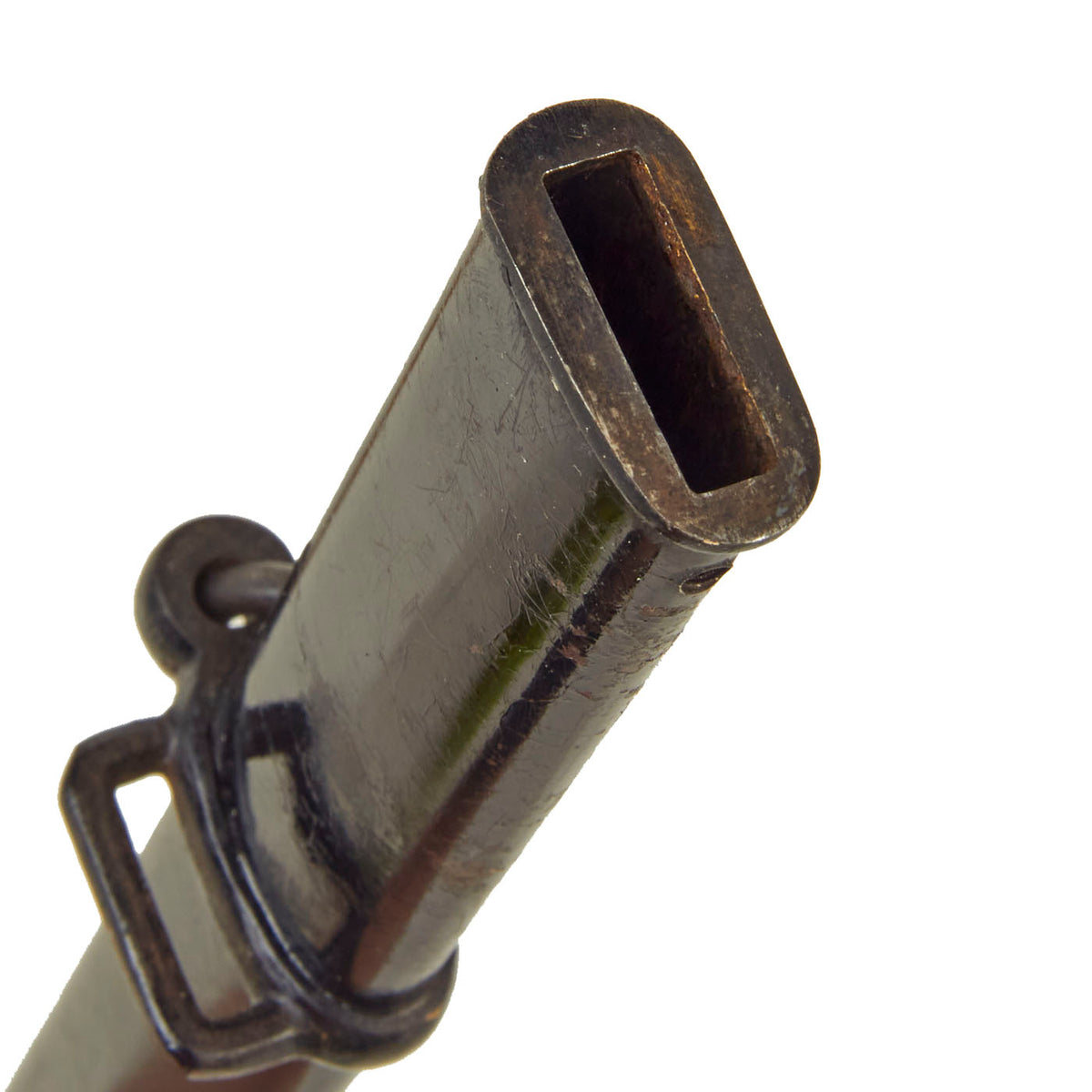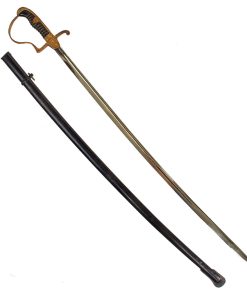Original German WWII Army Officer Emil Voos Pattern Dove Head Sword with Steel Scabbard Original Items
$ 695,00 $ 208,50
Original Item: Only One Available. This Army Dove Head Sword is a fantastic condition example, with an excellent nickel plated blade and black enameled scabbard. The blade is unmarked, but the shape of the fittings definitely attributes this sword to Emil Voos of Solingen, who was known to have produced unmarked examples.
The dove head and backstrap are embossed with the classic German oak leaves and acorns motif, which extends onto the side tabs. The “flat” P guard has the same motif, as does the grip ferrule. There are lots of hand enhancing and many of the backgrounds have received pebbled decoration. The chappe/langet features a raised out Emil Voos style “closed wing” National eagle, which shows excellent detail to his beak, eye, breast feathering, wing feathering, talons and mobile clutched swas. The other side is a blank shield and would often be used for the officer to add a monogram, however this example is still blank.
The grip of this example is a black celluloid over a carved wood base. The celluloid is still in excellent condition with no cracking or other degradation that we can see. The grip is wrapped with 4 wires, with the center pair twisted together, and all still line up with the grooves correctly. There is just a bit of play in the guard / hilt connection with the blade.
The nickel plated blade is 30 1/2 inches long, with the original leather blade washer is in place. This blade is of high quality spring steel, and the plating is still in very good shape, with just a bit of scuffing and scratching in places, and no major flaking or other issues.
While there is no trademark on the blade of this example, many identical design Dove’s head with large langets and this eagle style have been attributed to Emil Voos of Solingen. Please see page 126 of SWORDS OF GERMANY 1900-1945 by John R. Angolia regarding the “Emil Voos” pattern of officer swords. Please also see this Emil Voos marked example of a Lion’s head sword with an IDENTICAL eagle and crossguard design, sold by IMA previously: Original German WWII Officer’s Lion Head Sword with Scabbard by Emil Voos of Solingen.
Emil Voos, Waffenfabrik, also known as a Spezialfabrik für Jagd- und Sportmesser (Special Factory for Hunting and Sporting Knives), was a Solingen-based knife maker founded in 1925. The “Serpent-and-Stump” logo next to the name and location was used on most military and police swords such as this the WWII period, per J. Anthony Carter’s work GERMAN KNIFE AND SWORD MAKERS. The original leather blade washer is still present and in great shape.
The black enamel paint of this scabbard is mostly complete, but shows a lot of checking and crazing, which has caused the finish to flake off in places. This has exposed the steel of the scabbard, so there is some oxidation in places, but it does not go beyond staining. It has a fantastic “aged” look, which is simply impossible to duplicate. The hanger ring is still intact, and one of the two screws on the throat is missing.
Overall a great condition example of an Emil Voos pattern German Army Officer Dove Head sword, complete with scabbard. Ready to display!
Specifications:
Blade Length: 30 1/2″
Blade Style: Single Edge w/ Fuller
Overall length: 35 1/2“
Guard dimensions: 5″ width x 5” length
Scabbard length: 31 1/2”
The German Army (German: Heer, was the land forces component of the Wehrmacht, the German armed forces, from 1935 to 1945. The Wehrmacht also included the Kriegsmarine (Navy) and the Luftwaffe (Air Force). During World War II, a total of about 15 million soldiers served in the German Army, of whom about seven million became casualties. Separate from the army, the Waffen-SS (Armed SS) was a multi-ethnic and multi-national military force of the Third Reich. Growing from three regiments to over 38 divisions during World War II, it served alongside the army but was never formally part of it.
Only 17 months after AH announced publicly the rearmament program, the Army reached its projected goal of 36 divisions. During the autumn of 1937, two more corps were formed. In 1938, four additional corps were formed with the inclusion of the five divisions of the Austrian Army after the Anschluss in March. During the period of its expansion by Adolf AH, the German Army continued to develop concepts pioneered during World War I, combining ground (Heer) and air (Luftwaffe) assets into combined arms teams. Coupled with operational and tactical methods such as encirclements and the “battle of annihilation”, the German military managed quick victories in the two initial years of World War II, prompting the use of the word Blitzkrieg (literally lightning war, meaning lightning-fast war) for the techniques used.
The German Army entered the war with a majority of its infantry formations relying on the horse for transportation. The infantry remained foot soldiers throughout the war; artillery also remained primarily horse-drawn. The motorized formations received much attention in the world press in the opening years of the war, and were cited as the main reason for the success of the German invasions of Poland (September 1939), Norway and Denmark (April 1940), Belgium, France and Netherlands (May 1940), Yugoslavia (April 1941) and the early campaigns in the Soviet Union (June 1941). However their motorized and tank formations accounted for only 20% of the Heer’s capacity at their peak strength.
Fast Shipping with Professional Packaging
Thanks to our longstanding association with UPS FedEx DHL, and other major international carriers, we are able to provide a range of shipping options. Our warehouse staff is expertly trained and will wrap your products according to our exact and precise specifications. Prior to shipping, your goods will be thoroughly examined and securely secured. We ship to thousands clients each day across multiple countries. This shows how we're dedicated to be the largest retailer on the internet. Warehouses and distribution centres can be located throughout Europe as well as the USA.
Note: Orders with more than one item will be assigned a processing date depending on the item.
Before shipping before shipping, we'll conduct a thorough inspection of the items you have ordered. Today, the majority of orders will be delivered within 48 hours. The delivery time will be between 3-7 days.
Returns
The stock is dynamic and we cannot completely manage it because multiple stakeholders are involved, including our factory and warehouse. So the actual stock may alter at any time. It's possible that you may not receive your order once the order has been made.
Our policy is valid for a period of 30 days. If you don't receive the product within 30 days, we are not able to issue a refund or an exchange.
You can only return an item if it is unused and in the same state as the day you received it. You must have the item in its original packaging.
Related products
Uncategorized
Uncategorized
Uncategorized
Uncategorized
Uncategorized
Uncategorized
Uncategorized
Uncategorized
Uncategorized
Uncategorized
Uncategorized
Uncategorized
Uncategorized
Uncategorized
Uncategorized
Uncategorized
Uncategorized
Uncategorized
Australian WWII Owen MK1 Machine Carbine SMG Custom Fabricated Replica with Sling Original Items
Uncategorized
Uncategorized
Band of Brothers ORIGINAL GERMAN WWII Le. F.H. 18 10.5cm ARTILLERY PIECE Original Items
Uncategorized
